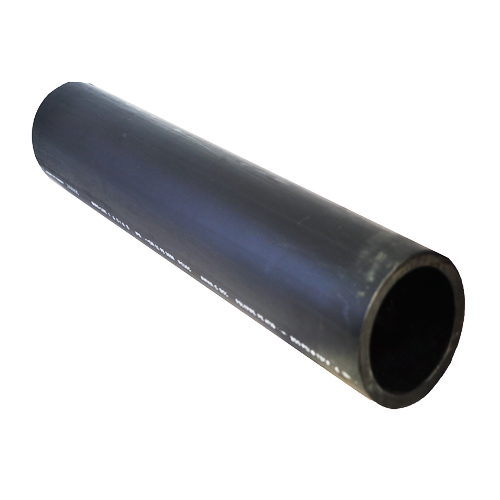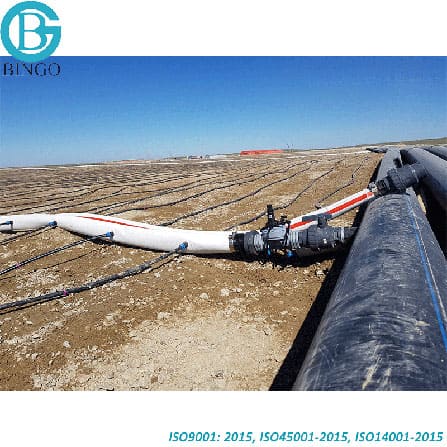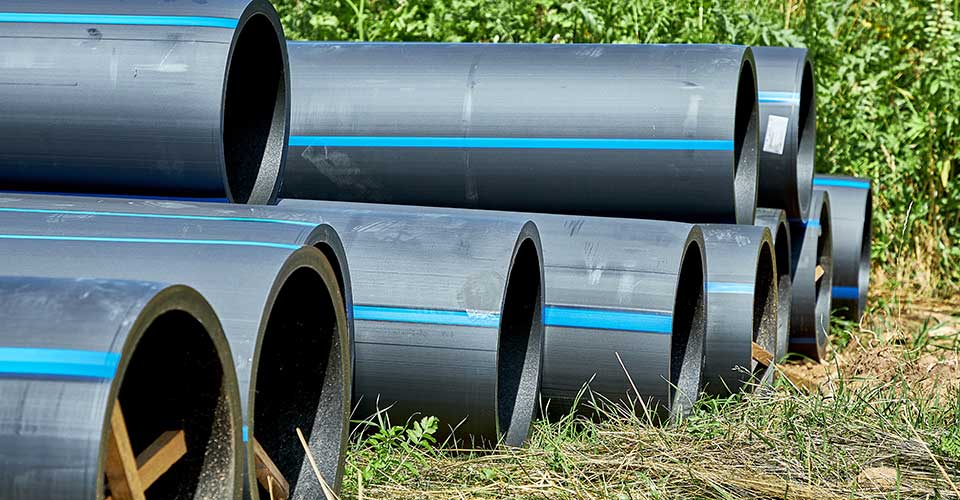How to Install hdpe pipe fittings Midland TX for Optimal Flow
Check Out the Production Refine Behind High-Quality HDPE Pipeline and Its Applications
The manufacturing process of high-quality HDPE pipelines is intricate and methodical. It begins with the choice of basic materials that enhance performance. Following this, ethylene undergoes polymerization to create resin, which is then formed via extrusion. Quality control is paramount, guaranteeing that the end product meets rigid criteria. The journey of HDPE pipes doesn't end with production. Their applications throughout different markets disclose a wider importance worth taking a look at.
Understanding HDPE: Features and Advantages

High-density polyethylene (HDPE) is a flexible thermoplastic recognized for its resilience and resistance to numerous ecological elements. This material exhibits exceptional tensile toughness, making it ideal for demanding applications. Its low-density framework adds to a light-weight item, facilitating simplicity of handling and setup. HDPE likewise showcases impressive resistance to chemicals, which minimizes degradation when exposed to harsh materials.
The material's reduced moisture absorption additionally boosts its longevity, making it suitable for use in pipes and tank. Additionally, HDPE is resistant to ultraviolet (UV) radiation, making certain that products keep their honesty also when subjected to sunlight. Its flexibility permits for the development of detailed shapes without endangering strength. The environment-friendly nature of HDPE, frequently acquired from recycled products, contributes to its charm, promoting sustainable methods in manufacturing. Generally, these homes and benefits make HDPE a favored option for various commercial and consumer applications.
Resources Selection for HDPE Manufacturing
The selection of resources for HDPE manufacturing is necessary to confirm the final product fulfills the preferred specs and top quality standards. High-density polyethylene (HDPE) is primarily created from polymerized ethylene, stemmed from nonrenewable fuel sources such as gas or crude oil. The quality of these feedstocks substantially influences the mechanical and thermal properties of the final HDPE.
Additives also play a substantial function in boosting HDPE's performance, including anti-oxidants, UV stabilizers, and colorants, which boost sturdiness and resistance to ecological elements. The selection process should consider not just the chemical structure of the raw products yet also their handling attributes to ensure reliable manufacturing.
Furthermore, the sourcing of raw materials ought to prioritize sustainability and compliance with ecological regulations, as liable practices are necessary in today's market. Inevitably, careful basic material choice lays the structure for creating top quality HDPE pipelines ideal for varied applications.
The Extrusion Process: Forming HDPE Pipeline
The extrusion procedure plays a crucial role fit HDPE pipelines, starting with precise product prep work techniques that ensure perfect circulation and uniformity. Just as important is the layout of the die, which directly affects the final dimensions and surface area high quality of the pipeline. With each other, these aspects add greatly to the performance and quality of HDPE pipe manufacturing.
Product Preparation Strategies
Efficient manufacturing of HDPE pipes starts with meticulous product prep work methods, specifically the extrusion process. During this stage, high-density polyethylene material is first dried out to get rid of moisture, guaranteeing optimal flow qualities. The resin is then fed into the extruder, where it undertakes heating and melting, changing into a viscous state. This home heating process is very carefully regulated to keep the material's honesty and performance. The molten HDPE is compelled through a die, shaping it right into a continuous pipe type. Correct temperature administration throughout extrusion is crucial, as it directly impacts the product's properties and the final product high quality. As soon as formed, the HDPE pipeline is cooled and cut to specified sizes, all set for succeeding handling and applications.
Die Layout Significance
Precision in die layout plays an essential function in the extrusion process of HDPE pipelines. The die functions as the final shaping tool, directly influencing the pipe's measurements, wall thickness, and surface area coating. A properly designed die guarantees uniform product flow, decreasing problems such as abnormalities and vulnerable points. The geometry of the die must be maximized to suit the details properties of HDPE, including its thickness and thermal habits throughout extrusion. Furthermore, the cooling rate of the material as it goes through the die can substantially impact the pipe's architectural integrity. Investing in sophisticated die innovation is crucial for manufacturers aiming to generate high-grade HDPE pipes that meet sector standards and customer expectations.
High Quality Control Actions in HDPE Production
Different elements affect the high quality of HDPE pipe production, effective high quality control procedures are important to guarantee uniformity and reliability in the final product (Midland TX HDPE Pipe Fittings in Stock). Secret quality control practices include rigorous product inspection, confirming that the raw polyethylene meets established standards for purity and density. Throughout the extrusion process, criteria such as temperature, pressure, and cooling time are closely kept an eye on to preserve dimensional precision and architectural stability
On top of that, post-production screening is essential; producers often carry out hydrostatic examinations to analyze the pipeline's stamina and resistance to stress. Aesthetic assessments for surface problems even more boost quality control. Qualification from pertinent requirements companies, like ASTM or ISO, gives an extra layer of credibility. By executing these thorough quality assurance procedures, producers can minimize problems, enhance performance, and make sure that the HDPE pipelines fulfill the particular requirements of different applications, inevitably bring about client complete satisfaction and rely on the product.
Applications of HDPE Pipe Across Industries
HDPE pipelines are used across various sectors because of their sturdiness and adaptability. In water distribution systems, they assure efficient distribution, while in wastewater administration, they supply reputable remedies for waste transport. In addition, farming irrigation networks take advantage of HDPE's resistance to corrosion and versatility, making Learn More Here it an excellent selection for modern-day farming practices.

Water Distribution Solutions
A substantial number of sectors count on high-density polyethylene (HDPE) pipelines for reliable water distribution systems. Recognized for their sturdiness and resistance to deterioration, HDPE pipes are widely made use of in municipal water networks, farming watering, and industrial applications. Their light-weight nature promotes easy handling and setup, minimizing labor costs and time. Furthermore, HDPE pipelines can suit various pressure levels, making them ideal for both low and high-pressure systems. Texas hdpe pipe manufacturer. The flexibility of the product enables smooth assimilation right into existing framework, minimizing the need for considerable excavation. HDPE's resistance to chemical leaching warranties that the water delivered remains secure and tidy, making it an excellent option for keeping the quality of safe and clean water throughout numerous markets.
Wastewater Management Solutions
Effective water circulation systems likewise lead the way for ingenious wastewater administration solutions, where high-density polyethylene (HDPE) pipelines play a considerable duty. Popular for their sturdiness and resistance to corrosion, HDPE pipelines are ideal for delivering wastewater in various setups. Their adaptability allows for very easy setup in complex environments, reducing the requirement for extensive excavation. Furthermore, HDPE's smooth indoor surface area decreases friction, improving circulation prices and effectiveness. These pipelines are also immune to chemical leaching, ensuring that pollutants do not endanger the surrounding setting. Industries, municipalities, and treatment centers progressively count on HDPE pipelines for their integrity and durability, making them a favored choice for modern-day wastewater administration systems. This flexibility highlights the essential significance of HDPE pipes throughout countless applications.
Agricultural Watering Networks
Agricultural watering networks benefit greatly from making use of high-density polyethylene (HDPE) pipes, which offer effective and reputable water delivery to plants. HDPE pipelines are lightweight, making them easy to carry and mount, while their versatility enables different setups in varied surfaces. These pipes demonstrate superb resistance to rust, chemicals, and UV radiation, ensuring longevity in rough farming environments. Additionally, their smooth indoor surface minimizes rubbing loss, enhancing water flow and reducing power costs connected with pumping. The durability of HDPE pipelines, usually surpassing 50 years, adds to decrease upkeep and replacement expenditures. Farmers increasingly depend on HDPE pipelines to enhance irrigation effectiveness and advertise sustainable farming methods, ultimately leading to enhanced plant returns and source conservation.

Future Trends in HDPE Pipe Modern Technology
As the demand for lasting and effective facilities grows, innovations in HDPE pipeline innovation are positioned to transform different sectors. Arising trends consist of the assimilation of clever technologies, such as sensing units and IoT capacities, which help with real-time surveillance of pipeline conditions, minimizing upkeep expenses and preventing leaks. Additionally, the advancement of sophisticated manufacturing methods, such as 3D printing, is allowing the production of facility, tailored pipeline designs that accommodate particular job requirements.
The focus on recycling and round economic climate techniques is driving the advancement of HDPE pipes made from recycled materials, enhancing sustainability. Boosted jointing approaches, such as electro-fusion and mechanical fittings, are likewise enhancing installation performance and dependability. Lastly, the growing emphasis on ecological laws is pushing producers to adopt greener production processes, guaranteeing that HDPE pipelines not just fulfill market standards however also click this foster an even more lasting future for framework growth.
Often Asked Concerns
Just How Does HDPE Compare to Other Plastic Products?
HDPE outperforms lots of various other plastic products relating to toughness, chemical resistance, and adaptability. Its low thickness and high tensile stamina make it ideal for various applications, typically going beyond choices in both efficiency and long life.
What Are the Environmental Influences of HDPE Production?
The ecological impacts of HDPE production consist of greenhouse gas discharges, power consumption, and prospective contamination from manufacturing processes. Furthermore, incorrect disposal can bring about soil and water contamination, raising concerns about long-term eco-friendly impacts.
Can HDPE Piping Be Reused?
Yes, HDPE pipes can be recycled. Several centers approve made use of HDPE for handling, transforming it right into brand-new items. This reusing adds to sustainability efforts, lowering plastic waste while conserving resources and energy in the production cycle.
What Is the Lifespan of HDPE Water Lines?

How Do Temperature Level Variations Influence HDPE Pipe Performance?
Temperature variations significantly affect HDPE pipe performance, water pipe ducting impacting versatility and strength. Heats can result in softening, while low temperature levels might trigger brittleness, inevitably influencing the pipeline's sturdiness and suitability for various applications in varied environments.